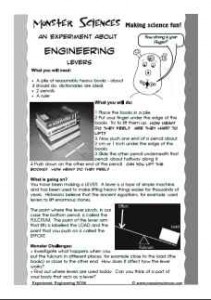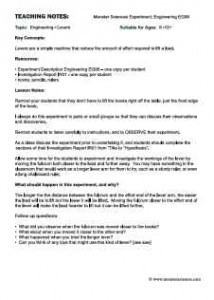In this Simple Machines science experiment your students are introduced to levers.
 |
 |
An Experiment about Engineering: Levers
What you will need:
• A pile of reasonably heavy books – about 4 should do, dictionaries are ideal.
• 2 pencils
• A ruler
What you will do:
1 Place the books in a pile.
2 Put your finger under the edge of the books. Try to lift them up. How heavy do they feel? Are they hard to lift?
3 Now push one end of a pencil about 2 cm or 1 inch under the edge of the books.
4 Slide the other pencil underneath that pencil, about halfway along it.
5 Push down on the other end of the pencil. Can you lift the books? how heavy do they feel?
What should happen:
You have been making a LEVER. A lever is a type of simple machine and has been used to make lifting heavy things easier for thousands of years. Historians believe that the ancient egyptians, for example, used levers to lift enormous stones.
The point where the lever pivots, in our case the bottom pencil, is called the FULCRUM. The point of the lever arm that lifts is labelled the LOAD and the point that you push on is called the EFFORT.
Monster Challenges:
• Investigate what happens when you put the fulcrum in different places, for example close to the load (the books) or close to the other end. How does it affect how the lever works?
• Find out where levers are used today. Can you think of a part of your body that acts as a lever?
Teaching Notes: Monster Sciences Experiment: Engineering EN06
Key Concepts:
Levers are a simple machine that reduce the amount of effort required to lift a load
Resources:
• Experiment Description Engineering EG06 – one copy per student
• Investigation Report IR01 – one copy per student
• books, pencils, rulers
Lesson Notes:
Remind your students that they don’t have to lift the books right off the table, just the front edge of the book.
I always do this experiment in pairs or small groups so that they can discuss their observations and discoveries.
Remind students to listen carefully to instructions, and to OBSERVE their experiment.
As a class discuss the experiment prior to undertaking it, and students should complete the sections of their Investigation Report IR01 from ”Title to “Hypothesis”.
Allow some time for the students to experiment and investigate the workings of the lever by moving the fulcrum both closer to the load and further away. You may have something in the classroom that would work as a longer lever arm for them to try, such as a sturdy ruler, or even a long chalkboard ruler.
What should happen in this experiment and why?
The longer the the distance between the fulcrum and the effort end of the lever arm, the easier the load will be to lift but the lower it will be lifted. Moving the fulcrum closer to the effort end of the lever will make the load heavier to lift but it can be lifted further.
Follow up questions:
• What did you observe when the fulcrum was moved closer to the books?
• What about when you moved it closer to the other end?
• What happened when you tried the longer lever?
• Can you think of any toys that might use this kind of lever? [see saw]



